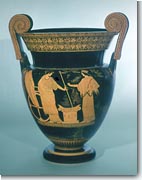









         | |
|
During the late Archaic period |  |
 |
From the painters who decorated large vases the painter of Cleophrades and the Berlin Painter can be distinguished. The first one is characterized by tension, dynamism and dramatic movement in his works, elements which are obviously influenced by Euthymides. His figures are easily discerned for the details of the eyes, the nostrils and the ear lobes. Among his most interesting works are a crater and an amphora with Dionysian scenes, as well as a kalpis with scenes from "Iliu Persis", a very symbolic theme, if we consider that in the same period Greece faced the Persian invasion. |
Among the painters of small vases, who mainly decorated kylikes, two are notable: Onesimos with his dynamic but balanced compositions and the Brygus Painter , who despite imperfections in design he managed to give expressiveness and vividness to his figures. Another kylix painter, Douris, had remarkable designing abilities, which were, however, exhausted in repetitions of known issues from daily life, and which showed, towards the end of his career, some signs of mannerism. Makron had similar abilities, who besides kylikes decorated many skyphoi as well. He rarely worked on mythological issues and his figures are somewhat solid, but careful and detailed. |
|
| |
|
Note: Click on picture for short description. | |